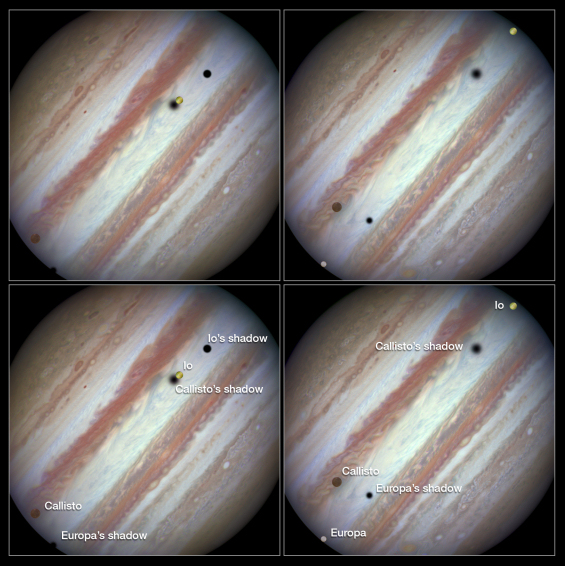March of the moons - Hubble captures rare triple moon transit of Jupiter [heic1504]
5 February 2015
These new NASA/ESA Hubble Space Telescope images capture a rare occurrence as three of Jupiter's largest moons parade across the giant gas planet's banded face. Hubble took a string of images of the event which show the three satellites – Europa, Callisto and Io – in action.
 |
| Three moons and their shadows parade across Jupiter. Credit: NASA, ESA, Hubble Heritage Team |
There are four Galilean satellites – named after the 17th century scientist Galileo Galilei who discovered them [1]. They complete orbits around Jupiter ranging from two to seventeen days in duration. The moons can commonly be seen transiting the face of Jupiter and casting shadows onto its layers of cloud. However, seeing three of them transiting the face of Jupiter at the same time is rare, occurring only once or twice a decade.
The image on the left shows the Hubble observation at the beginning of the event. On the left is the moon Callisto and on the right, Io. The shadows from Callisto, Io and Europa are strung out from left to right. Europa itself cannot be seen in the image.
The image on the right shows the end of the event, just over 40 minutes later. Europa has entered the frame at lower left with slower-moving Callisto above and to the right of it. Meanwhile Io – which orbits significantly closer to Jupiter and so moves much more quickly – is approaching the eastern limb of the planet. Whilst Callisto's shadow seems hardly to have moved, Io's has set over the planet's eastern edge and Europa's has risen further in the west. The event is also shown from start to finish in a video.
Missing from this sequence is the Galilean moon Ganymede which was outside Hubble's field of view.
The moons of Jupiter have very distinctive colours. The smooth icy surface of Europa is yellow-white, the volcanic sulphur surface of Io is orange and the surface of Callisto, which is one of the oldest and most cratered surfaces known in the Solar System, is a brownish colour.
The images were taken with Hubble's Wide Field Camera 3 in visible light on 23 January 2015. Whilst Hubble captures these moons in great clarity they can also be seen with a small telescope or even a decent pair of binoculars. Why not try it at home?
Notes
[1] These were among the first observations ever made using a telescope. They revolutionised our understanding of the Universe, and finally laid to rest the theory that the Earth is the centre of the Solar System.
Notes for editors
The Hubble Space Telescope is a project of international cooperation between ESA and NASA.
Contact
Georgia Bladon
ESA/Hubble Public Information Officer
Garching bei München, Germany
Tel: +44 7816291261
Email: gbladon![]() partner.eso.org
partner.eso.org







